#Urban Healer
Photo

Maybe if i post this comic i'll actually start working on this comic again :P
0 notes
Photo

I've got no new pages so here's a reminder to check out Urban Healer
What the title says!!!!
You should be here If you haven't been checking in!!! : The Page Where you left off!!!
0 notes
Text
Querencia 15 - Park Day
The enthusiastic response I got on the last piece I posted helped motivate me to keep going! This is the actual chronologically next chapter, coming in a month or two after Mind Control. Enjoy!
Taglist: @darthsutrich , @inky-whump , @painful-pooch , @pigeonwhumps , @bookworm2107
Previous | Next | Masterlist
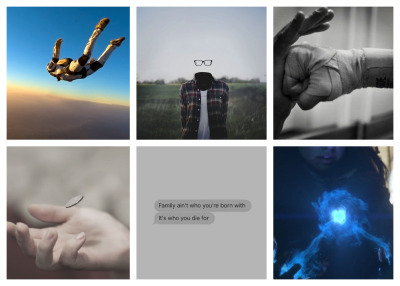
Contains: referenced mind control, referenced parental abandonment, fear of abandonment, broken bone, a couple more warnings in the tags to avoid spoilers here
.
.
Things have been fairly normal since the whole “supervillain getting in Jamil’s head and making him attack everyone” incident. Dagger is still a near-weekly problem, along with Meltdown and whoever else he happens to be hanging out with at the moment. Other villains come and go, too, some low-level Supers like Reaper and Gibbous, along with non-Super nuisances that the team does their best to curb, too - bank robbers and muggers and kidnappers and such.
No one has heard anything from or about Luna. Then again, no one had heard of her before the incident, either. Which means she’s probably still out there, and could very well be biding her time until she can strike again. None of them ever really talk about her, but Liliana can feel anxiety hanging in the air that wasn’t there before, especially on poor Jamil’s part.
Luna knows exactly where they live, what they look like without their masks on. Probably knows their names and where they work, thanks to rummaging through Jamil’s brain. So not only could she easily return, but she could also tell others the information she learned. They don’t know who she might be associated with. They managed to pin down Reaper one day and quiz him about her and any other new villains in town, but he was less than helpful on the subject.
Even if they could track her down and catch her, Liliana has learned from snippets of conversation that they really have nothing to do with her. It’s something she’s never thought of before, but one reason that there are still so many supervillains around is that there’s no way to arrest them. The government likely could detain them, but no one trusts that it would be humane or that the heroes wouldn’t also be captured in the process of trying to hand them over. Just the thought of the government locking them up makes Liliana sick to her stomach, villains or not.
Normal jails can’t handle them. Normal courtrooms can’t, either, in order to convict them to send them to jail. And no hero wants to be in charge of locking them away themselves, even if they did have the space and technology.
So all they can do for now is damage control, really. Try to stop their crimes as often as they can, try to disrupt whatever plans they have. She doesn’t envy the team their jobs. Between supervillains, regular criminals, and their day jobs, they’re constantly busy.
Every other Saturday, though, after everyone who’s working gets home, they make it a point to go do something together. Since Liliana’s been with them they’ve seen a couple of movies, gone to an arcade, had a picnic, gone to the mall, and eaten out at restaurants a few times. Every experience is a huge deal for her, though she tries to make light of the awe she feels. It’s just been so long since she’s done such normal, fun things. Sometimes she feels like she’s watching someone else’s life.
Today, they’re at the city park. No one can remember whose idea it was to start with, but “the children” - as Quinn likes to fondly dub Nari, Alex, and Jamil - went crazy over the thought of playing on the playground, so here they are. It’s late enough that all of the actual children have gone home. Jamil is trying out every slide, while Quinn judges Nari and Alex in a series of competitions on the monkey bars. Liliana watches everyone from the side, a small smile on her face, but every once in a while she glances over at the empty swings.
Swinging used to be her favorite. Especially on park or school swings like these, with the long chains that could take you so high you felt like you were flying. She and Mila used to see who could go the highest, and try to swing themselves right over the top bar.
It feels silly and childish now. She can’t swing herself right now, anyway. She healed another broken rib - on Nari this time - earlier this week, just a couple of weeks after the pain from Alex’s had finally faded. So there’s no way that she can pump the chains on a swing.
Still…she could just sit in one. That won’t hurt anything. Glancing over at the chin-up contest again, she makes her way over and settles into the plastic seat, gloved hands gripping the chains loosely. Her toes just barely reach the ground, giving her enough leverage that she can give herself a little push. The swing rocks gently. Liliana watches her sneakers as they brush across the dirt, back and forth. She pushes again and swings a little more. Such a simple motion, but it brings so many childhood memories flooding into her mind.
“May I give you a push?”
The sudden question makes her jump and look back over her shoulder, though she recognizes the voice. Jamil is standing behind her with a smile on his face, cheeks flushed from his adventures down the slides.
“Oh, um…y-you don’t have to, I’m…I’m fine.”
“I know I don’t have to, but I’d like to, if you’d like to swing. If not, I’ll leave you be!”
Now her mind is at war. She automatically wants to say no, not wanting to inconvenience him or make him do things for her.
She also really, really wants to swing.
Somehow, without her actually deciding what to say, “Sure?” slips out.
“Alright, hang on!”
Suddenly, she’s flying through the air, and it’s exactly how she remembers it. Colors rush by as the wind blows her curls back off her shoulders, then tangles them around her cheeks again. She grabs onto the chains tighter. Her legs automatically fall into a pumping motion, toes pointing out at the horizon, her eyes bright with exhilaration.
Yes, it pulls at her rib a bit. But she finds she doesn’t really care.
She’s been swinging for a few minutes, oblivious to anything else around her, when another voice breaks in. “Hold on tight, I’m coming through!” A set of hands grab the swing by her hips and shove forward, higher and faster until she’s sure she actually is going to go over the top bar, or more likely, fall out the back of the swing. She squeals in shock, though this sensation is familiar, too. Then she’s dropped abruptly, her stomach following the motion, the swing’s momentum twisting it back and forth as it reaches the bottom again.
Alex is turned around watching her, laughing. He’d come up from behind and grabbed the swing, running all the way underneath it.
Her brother used to do the very same thing, back when she was small enough he could lift her.
“Did I scare you?”
“A, a little.” She’s smiling, though. She can’t help it, even with the pain in her side and the melancholy of missing what used to be.
These people…they treat her like a family should. Better than her family ever did, though she feels like a traitor for thinking it.
She shouldn’t fall for it. If her real family taught her anything, it’s that what seems like love and care won’t last and can’t be trusted. If her own flesh and blood eventually turned on her, then she can’t expect people who were strangers a few months ago to be any different.
But right now, she’s shoving those thoughts deep, deep down. She can worry about all of that later. Right now, for once, she’s going to let herself enjoy the moment.
Nari is shoving and punching Alex and playfully fussing at him for scaring Liliana, and Jamil has jumped up on the swing next to her, standing on one foot and pumping with his arms. She doesn’t move from her spot, just keeps smiling and watching their antics. They’re so full of life and joy, even with the stress they constantly face.
Before long Quinn takes up Jamil’s position without a word, and she’s swinging again. Alex and Jamil balance on the seesaw, attempting circus tricks, screaming like girls when Nari uses her power to make the metal move beneath them, which sends her into fits of laughter.
It’s late when they finally pile into Quinn’s car to head back to HQ. Everyone is tired in a contented way. Alex leans the passenger seat back practically into Nari’s lap, claiming he’s going to take a nap, while she kicks his headrest repeatedly and threatens him. Quinn clears his throat loudly, though, and quiet falls to let him focus and not overwhelm him with sound in the small space.
Liliana leans her head back and watches the moon out the sunroof. Her hands are tucked between her knees to keep her arms from brushing up against Jamil and Nari, who each lean into their respective doors to give her more space. It’s…peaceful. She’s pretty sure she hears someone snoring. She could fall asleep, too, honestly, which is surprising for her since she doesn’t usually feel comfortable sleeping unless she’s alone.
The motion of the car does lull her into a near-dozing state. Her eyes are closed and she’s absentmindedly trying to picture which turn they’re taking when someone gasps and the car suddenly jerks to one side. Liliana’s eyes fly open and she sits up abruptly. There’s a bump and a loud popping and hissing sound, then the car is swerving uncontrollably, headlights sweeping back and forth across the empty road.
The seconds seem to pass in slow motion. Her hands are gripping the seats in front of her, eyes fixated out the front windshield. A cacophony of screams and shouted words fill the car as the steeply sloped side of the road looms in front of them, cutting off abruptly as they tip over the side and begin to fall.
Gravity inverts, and for a moment she’s weightless before being slammed back down. Her temple smashes into something hard and unyielding. Images are swimming through the darkness around her - a cracked window, slumped figures. A beam of light making her wince and turn away.
Someone groans. The car shakes as a door is forced open.
“This one’s still awake.”
“Here, use the syringe.”
There’s movement around her, the click of seatbelts unbuckling too loud in her ears.
“Wait, why are there five?”
“What?”
“This one, who is she? She’s not one of the usuals, is she?”
“Doesn’t matter, just grab her.”
Something is very, very wrong, but she can’t make her body work to do anything about it. The darkness outside is creeping closer inward. She feels her seatbelt loosen and a pair of hands latch onto her, but the darkness closes in completely before she can protest.
#querencia#liliana the healer#quinn the leader#nari the hero#alex the hero#jamil the hero#lady whump#lady whumpee#broken ribs#referenced parental abandonment#fear of abandonment#referenced mind control#car crash#kidnapping#urban fantasy#superheroes#heroes and villains#whump writing#whump series
22 notes
·
View notes
Text

The Stairwell Gang
(Left to right: Fighter, Leader/Healer, Cat, Wizard)
#art#drawing#illustration#photo#photography#urban#downtown#stairs#parking garage#character#character design#fighter#healer#cat#wizard#artists on tumblr
7 notes
·
View notes
Text
old man yaoi in my dnd dream
#the story was this ragtag bunch of outlaws had been gathered to pull off an oceans eleven style heist on this big magical casino.#It had a really cool cyberpunk/urban fantasy type setting#anyways the aforementioned old man yaoi was between the insectoid dark-elf wizard and the ex-bandit human barbarian#they had a very beautiful romance arc actually#the cast also included a master thief half-elf rogue and her robot helper. and a healer who looked like pleakly from lilo and stitch.#it was a truly amazing experience honestly#the whole thing first person shooter#i wanna draw the gang now I got really attatched to them throughout the course of that dream#dream diary
0 notes
Text
On Rastafari bush doctor
On Rastafari bush doctor
Photo by Simon Lister Photography
The dynamics of herbal medicine are complex within the Western Cape and are typically sectored into different groupings based upon cultural background.In contemporary Western Cape culture, particularly in urban Cape Town, a hybridization of cultures and healers has led to the development of neo–traditional healers, Rastafari bush doctors.
This group draws from…

View On WordPress
#2014#bossiedokters#bush doctor#Cape Town#faith#healers#herbalists#KhoiSan#RASTA#rastafari#South Africa#spiritual#The Informal Trade of Medicinal Plants by Rastafari Bush Doctors in the Western Cape of South Africa#urban#Xhosa
0 notes
Text


I made these charts to provide an easy reference guide for comparing the four Gospels! Feel free to share around wherever.
I think tumblr's crunching up these images so visit here for crisper versions (plus they're table format instead of png format).
Alt text version is under the readmore, necessarily formatted slightly differently but with all the same info.
TEXT ONLY / NON CHART VERSION:
Images show two charts, each credited to Avery Arden with a note that the material largely derives from the abridged version of Raymond E. Brown's An Introduction to the New Testament.
Chart 1: Comparing the Gospels, Part 1 – historical context
Mark
When:
Late 60s/early 70s
Who:
Jewish
Multi-lingual — peppers Aramaic into the Greek
Where:
Rome or Syria (clearly unfamiliar with Palestinian geography)
To whom:
Mainly to Gentiles new to Christianity who were experiencing persecution
Priorities:
Encourage audience and show them how their suffering fit into Jesus’ vision of the Kingdom of God
Matthew:
When:
Late 70s/80s
Who:
Jewish
Also multi-lingual, with Aramaic phrases;
Greek more polished than Mark’s
Where:
Probably in or near Antioch (in Syria); possibly Galilee
To Whom:
Mainly to well-educated Jews who were debating internally about how Jewish tradition fit into following Jesus
Priorities:
Promote Messiah Jesus who fulfills audience’s Jewish scriptures
inform church life and structure
Luke
When:
mid-to-late-80s
Who:
Gentile (possibly Jewish convert)
Educated Greek “historian” familiar with Septuagint;
no use of Aramaic; expert use of Greek
Where:
Probably Greece; possibly Syria; also unfamiliar with Palestine
To whom:
Mainly to wealthy Gentiles influenced by Paul’s mission; living in an urban setting
Priorities:
Promote Isaiah-like Jesus; challenge audience to live out faith more actively (e.g., by redistributing wealth)
John
When:
90s / as late as 110
Who:
Jewish
Student(s) of “the Beloved Disciple” (the “Johannine school”)
Where:
Traditionally Ephesus; possibly Syria
To whom:
To a mixed crowd of Jews & Gentiles, at a time when tensions between Jews who did & didn’t follow Jesus had reached an all-time high
Priorities:
Promote Jesus’s divinity; strengthen unity in a group increasingly defining itself as separate from Jewish ones
Chart 2: Comparing the Gospels, Part 2 — Thematic Content
Mark
Emphasizes Jesus as:
Jesus as miracle-worker / healer; human being
Unafraid to depict human limitations & emotions in Jesus
Other defining attributes / content:
Focuses on Jesus’s actions, e.g., his miracles; as well as on his suffering and death
Originally ended with the empty tomb & fear; no resurrection relief
The disciples often fail to understand Jesus; Jesus is frequently secretive about his identity
Matthew
Emphasizes Jesus as:
A Moses figure, Messiah, Son of God; teacher
Removes descriptions that make Jesus seem limited, naïve
Other defining attributes / content:
Beatitudes (ch. 5); judgment of the “sheep and goats” (ch. 25);
Instructions for intracommunal relationships; forgiveness; “Great Commission” (ch. 28)
Polishes Mark’s depiction of the disciples to present them more favorably (esp. Peter as the “rock” of the church)
Luke
Emphasizes Jesus as:
Self-aware Son of God; prophet of the poor
Removes descriptions that make Jesus seem emotional, harsh, or weak
Other defining attributes / content:
Beatitudes (ch. 6) — with added “woes”; frequent warnings about risks of wealth
Also depicts disciples more favorably
Favorable depictions of tax collectors as sinners on the way to redemption;
negative views of Pharisees as rejectors of Jesus, juxtaposed with stories of Gentiles who express faith
John
Emphasizes Jesus as:
Divine, the Word / “I Am�� made flesh; lamb of God
Often misunderstood by disciples & crowds due to his use of figurative language
Other defining attributes / content:
Poetic format, full of symbolism; similarities to Gnostic texts that arose in the same era
Lots of “testimony” and “signs”
Despite Jesus & his disciples being Jewish, John depicts “the Jews” as being against Jesus; his Jesus says things like “It is written in your law…”
226 notes
·
View notes
Text
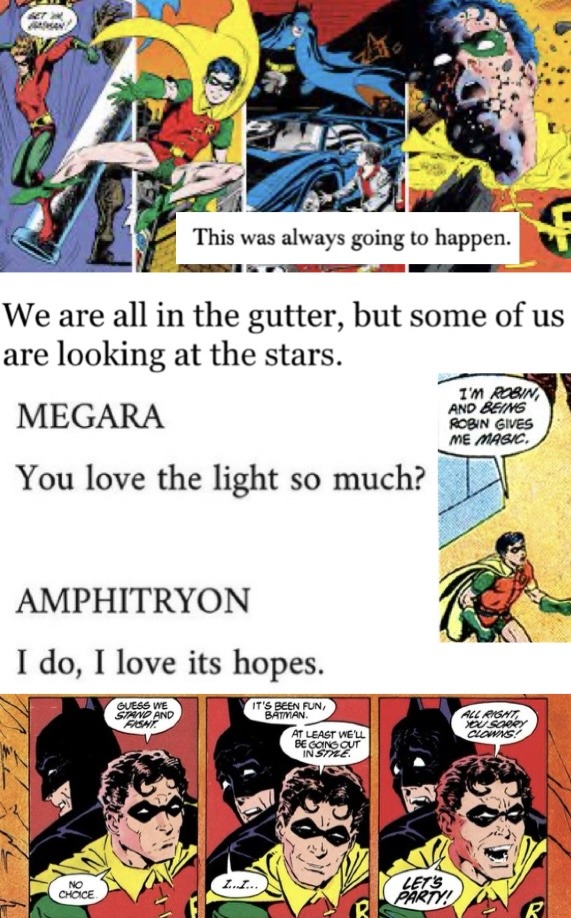
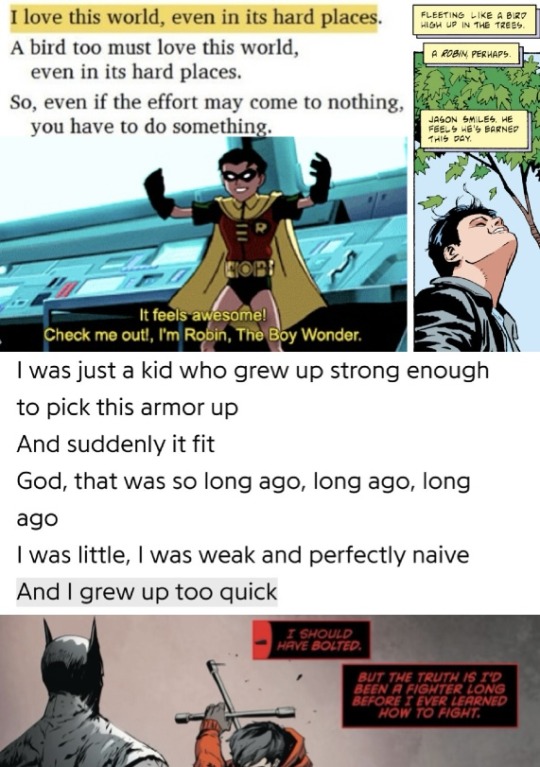




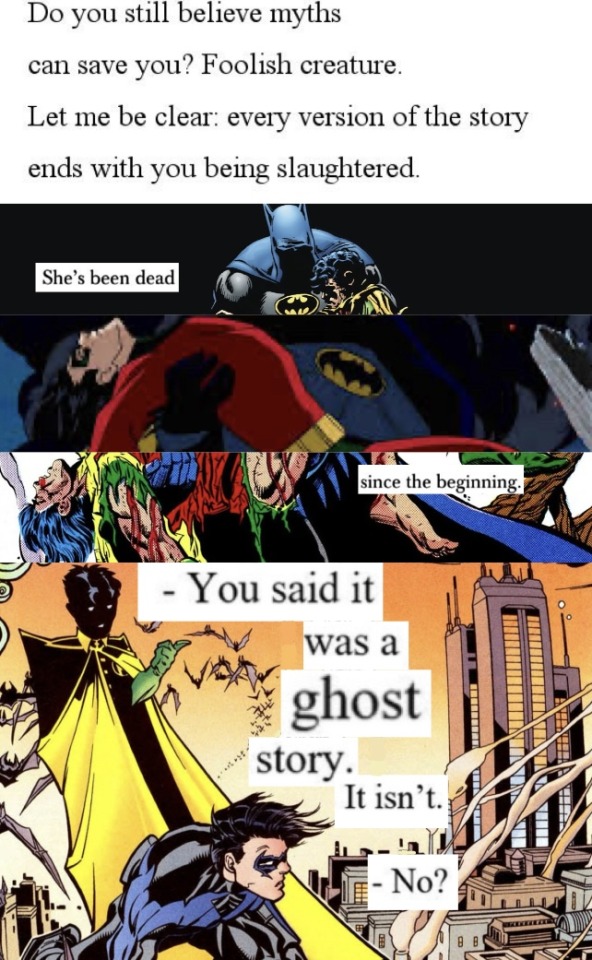
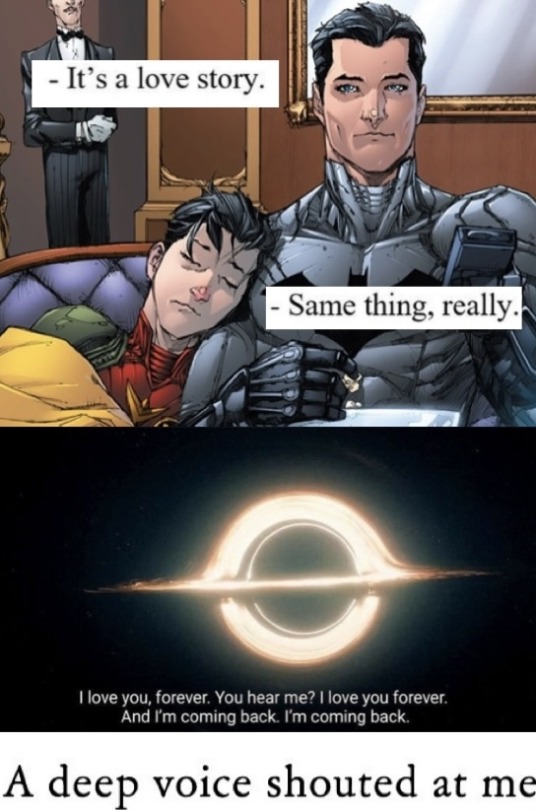

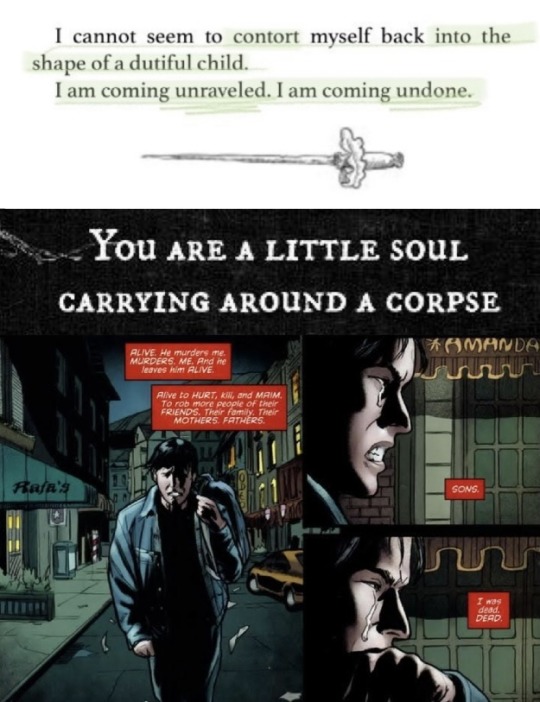
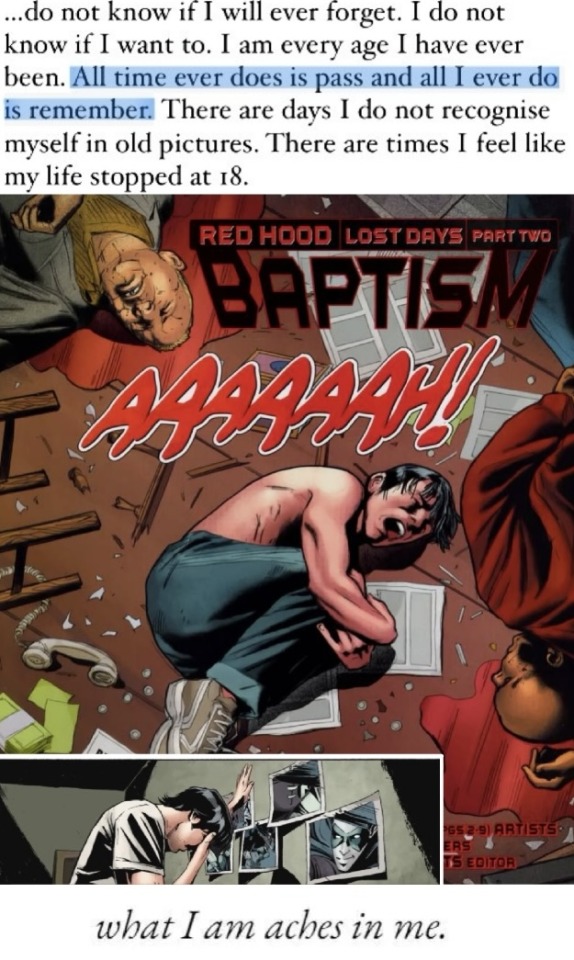

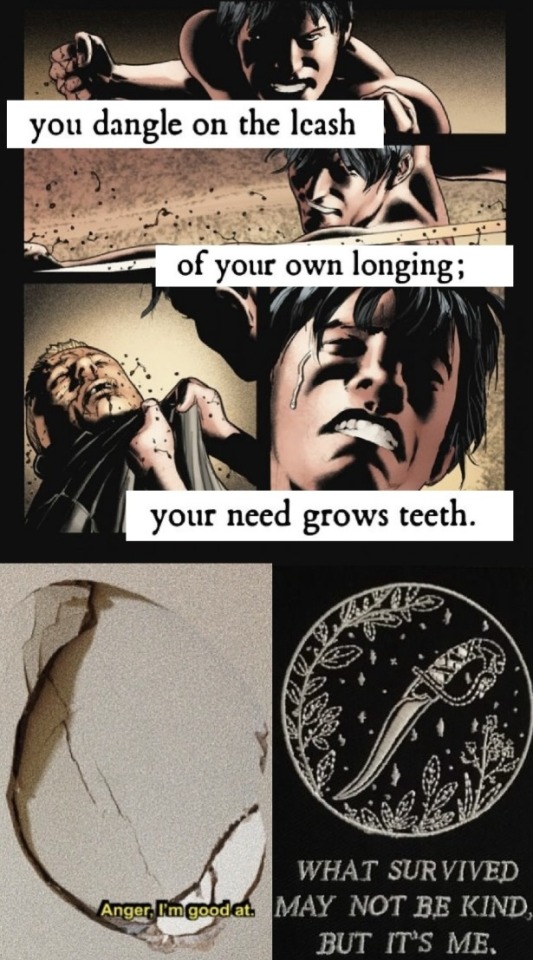

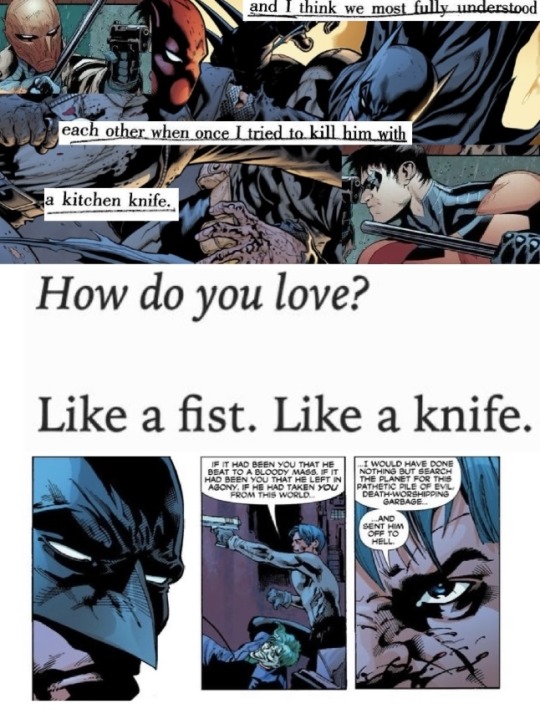
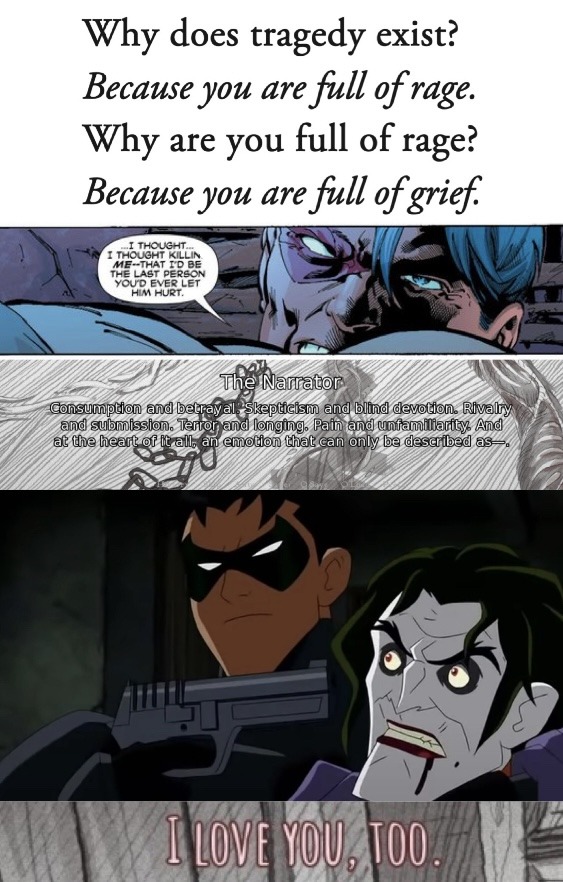
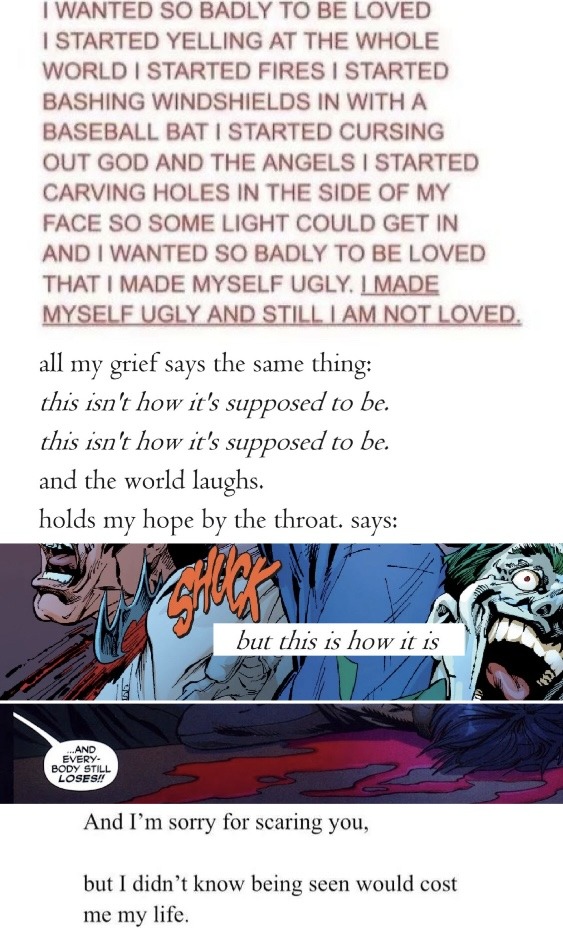

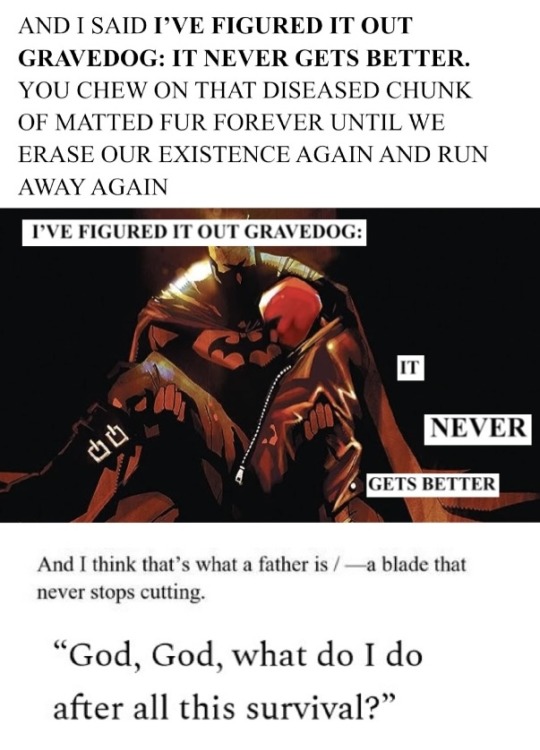

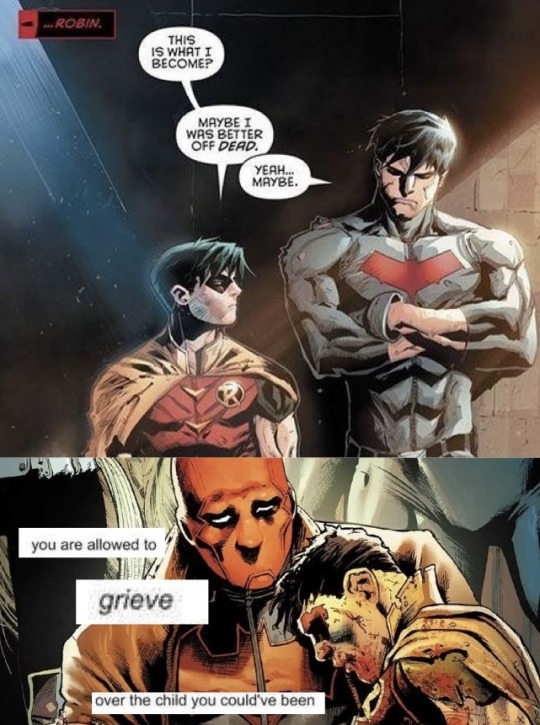



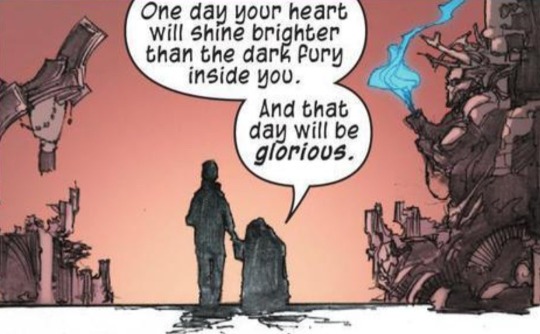


Jason (from the Greek Iásōn, “healer”) Peter Todd (from the German Tod, “death”) - I hope you find your way out of that grave.
dc comics + The Oresteia, Aeschylus / Lady Windermere’s Fan, Oscar Wilde / Grief Lessons: Four Plays [tr. Anne Carson], Euripides + Batman v1 #385 / Batman: The Cult #3 / For Example, Mary Oliver / Batman: Legends of The Dark Knight #100 / Batman: Under the Red Hood / Eight, Sleeping at Last / Red Hood and the Outlaws: Rebirth / Batman: Urban Legends #10 + ? / On Earth We’re Briefly Gorgeous, Ocean Vuong / Red Hood and The Outlaws #25 / Slay the Princess / pinterest + Batman #422 / Batman #424 + Rilke's Book of Hours: Love Poems to God, Rainer Maria Rilke + Batman #428 | A Death in the Family / @/metamorphesque, tumblr / American Teenager, Ethel Cain / Anecdote of the Pig, Tory Adkisson / interpretations of A Death in the Family + The Oresteia, Aeschylus / Nightwing: Secret Files and Origins #1 + the Haunting of Bly Manor + Red Hood and the Outlaws #23 / @/petrichara, tumblr / I Didn't Apologize to the Well, Mahmoud Darwish / Infinite Crisis: Secret Files + pinterest / Ruin and Rising, Leigh Bardugo / Red Hood and the Outlaws #26 / The Cruel Prince, Holly Black / pinterest / Red Hood: The Lost Days / Sue Zhao / Red Hood: The Lost Days part II + Red Hood: The Lost Days #4 / I See Boats Moving, Fernando Pessoa / Oedipus the King, TV Tropes / @/devilsmoon, tumblr / Red Hood: The Lost Days + Speeches for Dr Frankenstein, Margaret Atwood / Saving June, Hannah Arrington + embroidered patch / Slay the Princess / unaligned, @/hamletmaschine + Batman: Under the Red Hood / Batman: Under the Red Hood + Batman and Robin #11 + South and West: From a Notebook, Joan Didion / The Good Fight, Ada Limón / Batman: Under the Red Hood / Grief Lessons: Four Plays, Euripides [tr. Anne Carson] / Batman: Under the Red Hood / Slay the Princess / Under the Red Hood / Slay the Princess / @/sainticide, twitter / The Truth About Grief, Fortesa Latifi + Batman: Under the Red Hood / Batman: Under the Red Hood / Ten Legs, Eight Broken, mandana on tiktok / War of the Foxes, Richard Siken + Under the Red Hood + Batman #428 | A Death in the Family / The Unabridged Journals Of Sylvia Plath, Sylvia Plath / Under the Red Hood + Batman #428 | A Death in the Family / @baitmeat, tumblr + Batman: Under the Red Hood (Deluxe Edition) / Origin Story, Desireé Dallagiacomo / Vive, Vive, Traci Brimhall / The Dogs I Have Kissed, Trista Mateer + Batman: Under the Red Hood + Three Jokers / Red Hood and the Outlaws Rebirth #9 / @/sainticide, twitter + Red Hood and the Outlaws #10 / Would’ve, Could’ve, Should’ve, Taylor Swift / ? + Robin 80th Anniversary 100 Page Super Spectacular / Ep. 4: Joseph Campbell and the Power of Myth -- 'Sacrifice and Bliss', Joseph Campbell / White Knight #7 + Heaven, Mieko Kawakami / Forest Fire, Mitski / Red Hood and the Outlaws Vol. 2 #9 + Batman Annual #25 + Free Will Astrology, Rob Brezsny / Letter XV, @/lucidloving / Red Hood and the Outlaws Vol 1: REDemption / briscoepark + The Civil War, Anne Sexton [compiled by @/lovejoyparadox here] / @/soapstore, tumblr + I Await the Devil’s Coming, Mary MacLane + Claire C. Holland / @/havingrevelations, tumblr / Meditations in an Emergency, Cameron Awkward-Rich + Deathstroke #34 / Grief Lessons: Four Plays by Euripides [tr. Anne Carson] + Red Hood and the Outlaws
#Jason todd#batman#batfam#bruce wayne#web weaving#dick grayson#robin#dc comics#also all love quotes are platonic please do not ship!#also whoever kept putting slay the Princess on my dash I owe you my life
183 notes
·
View notes
Text
(Urban) fantasy situations to put your blorbos in
• One is the transformed dragon seeking refuge in a new place, the other is the sacrifice they did not ask for.
• The first is a werewolf, the second is the human they bring into their community, the third is the leader of the pack.
• One is sailor, the other is the mermaid whose song is either warning for a storm or calling it towards them.
• The first is the new resident of a home, the second is the ghost haunting it, and the third is the medium or exorcist brought in to help.
• One is wandering a graveyard at night, the other is a vampire trapped in a grave overgrown by wild roses.
• The first is a selkie who lost their pelt, the second is the one who finds the selkie, the third is the one who found or stole the pelt.
• One is suffering from a mysterious illness, the other is an (in)famous healer capable of seeing and bargaining with Death.
Please feel particularly invited to make these as platonic or romantic as you wish~
171 notes
·
View notes
Text
How a Kabbalist Accidentally Became an Arsonist: A True Tale of the Rabbi who Burned Down the Jewish Ghetto of Frankfurt in 1711 🔥🧵

By 1704, when he was invited to become Chief Rabbi of Frankfurt, Rabbi Naphtali Katz had gained renown throughout Ashkenaz as a Ba'al Shem—a shamanic healer, amulet writer, and kabbalist.

His tenure in Frankfurt was brief. It ended on Jan. 14th, 1711, when a fire spread from his home & reduced the Judengasse—then the largest Jewish community in Germany—to ashes.

He was arrested by German authorities on claims of arson & witchcraft and was held for five months before being exiled from Frankfurt.
Soon after the fire, this poster was hung by Christians throughout the Judengasse. The left side depicts the Jews fleeing the flames.

The right side reads (in part):
"Alas! The happiest [and] most unhappy day
On which at Frankfurt am Main
The Jewish quarter having been set ablaze
With Rabbi Naphtali the Pole being the cause
Within the space of 24 hours burned to the foundations."
How exactly did Rabbi Naphtali cause this urban wildfire? Johann Jacob Schudt, in his "Jewish Oddities"(1714, Frankfurt) records several rumors. One popular account blamed his kabbalistic malpractice...

"The Rabbi, who was a great kabbalist, had himself set the fire to show his students how he could extinguish the fire...(but) in his haste to put it out he had summoned the Prince of Fire instead of the Prince of Water & that is why the fire grew." Oops!
This is a painting made by the German Jewish artist Johann Nothnagel entitled, "Rabbi Naphtali Cohen with two Schoolchildren" (1772). It portrays this scene of angelic conjuring & accidental arson.

The Magen David image before him was part of a popular kabbalistic recipe for extinguishing fires. The radiant and hovering disk = the angelic Prince of Fire. Smoke emerges from the top right & the student's faces flash concern.
Nothnagel made a copy of this painting a few years later with one significant change: The abstract disk is replaced with a more concrete angelic figure.

Notice how this version has been modeled after another scene of angelic conjuring: Rembradnt's "Faust" (1652).

In a sort of full-circle, Rembrandt was likely modeling his portrait on tropes of Kabbalah popular during his time.

Who is the Prince of Fire (Sa'ar Ha-Esh)? Midrashic sources identify him with the archangel Gabriel.
"Michael is the angel of snow and Gabriel of fire; this one does not extinguish that one, and that one does not harm this one." (Shir Ha-Shirim Rabbah 3:11)
Sefer Ha-Razim, a magic text from the time of the Midrash, identifies two other angelic fire-archons: "Yabniel is in charge of all things concerning the igniting & extinguishing of fire... Deleqiel is in charge of flames of fire, to kindle or quench them."

Rashi (1040-1105) already reports that summoning these angels was uniquely difficult.

Interestingly, a very similar story to Rabbi Naphtali's arson is told about another Ashkenazi Ba'al Shem—The Ba'al Shem Tov/Besht. This version is from "In Praise of the Besht" (Kopust, 1814).

A second version of this story is told by a later hassidic master.

This incident would have occurred not long after 1711 (the Besht is born in 1698 & these tales occur in his youth). And, reportedly, the Besht knew of Rabbi Naphtali & mocked his ascetic model of practical Kabbalah.

The upshot? Don't start a fire to prove you can put it out + When Kabbalah is no longer theoretical but also "practical," its relationship to the elements and society is more acute & mistakes have material & historical consequences.
24 notes
·
View notes
Photo

A new update has Arrived!
Did you see? There is the udate of Alland from ERBAN HEALUR.
The family can enjoy it
https://urban-healer.tumblr.com/post/707259752315518976
0 notes
Text
Whumptober 2023 - Day 3 - Querencia
This takes place during Lili's facility days, somewhere in the midst of chapter 3.
Taglist: @darthsutrich , @inky-whump , @painful-pooch , @pigeonwhumps , @bookworm2107
Masterlist

No. 3: “Like crying out in empty rooms; with no-one there except the moon.”
Contains: minor whumpee (16-17) but it's only angst not physical whump, lady whump, implied imprisonment, insomnia
.
.
The moon is bright tonight. It must be full, or close to it. Liliana can’t tell for sure, she can’t ever get the right angle up through the small window at the ceiling to actually see it, but the way it’s lighting up the foot of her bed definitely makes it seem like a full moon.
She sits up, curling her legs to her chest and wrapping her arms around them, staring up at the window. It’s probably been at least an hour since the lights turned out and all the doors were locked - by her best guess, she doesn’t have a clock - but she can’t sleep. That’s not unusual. She has a hard time falling asleep most nights, or she’ll wake up randomly in the middle of the night and not be able to go back to sleep. She doesn’t have the option to turn on a lamp or the overhead light to do anything like read, though, so she just stays in bed and stares at the ceiling or the wall…or the dark expanse outside the window.
Tonight, the moonlight spilling across her bed reminds her of being a child. She was always fascinated by the moon. Normally, when she was really young, she’d be tucked into bed before it was dark enough to really see the moon, but sometimes she’d stay awake as long as she could so that she could peek out her curtains and catch a glimpse of it. Her Mamà taught her the little poem one night, when they were coming home from somewhere late and Liliana was enamored by the moon ‘following’ the car. “I see the moon, and the moon sees me…”
Even when she got a bit older, she would sometimes pretend that the moonlight would keep her safe from harm. Whenever the soft white light would come peeking through the blinds onto her bed, she’d crawl to the other end and curl up, letting the lines fall across her face and imagining she could feel its warmth.
Slowly, quietly, she does the same thing now. The battered metal frame of the bed squeaks as her weight transfers. She wiggles around until she can wrap the thin, scratchy sheet around herself in this new position, then settles into place and blinks up at the window once more.
She can just see the bottom portion of the moon. She’s bathed in its light, much more so than when it was shining through her blinds, but…she doesn’t feel anything.
There’s no warmth. There’s no protection. The moon isn’t magical, it’s just a cold, unfeeling light, looking down at her struggles and heartache with apathy. Back when she was a child, pretending it was something more, she was already safe. She had nothing to worry about. She was lying in her cozy bed on top of soft blankets, surrounded by her beloved plushies with a family who loved her just down the hall.
But the moon didn’t keep her safe, and neither did anything else. And trying to bring back a little bit of that lost childhood while lying on a rock hard mattress in a cold room locked from the outside feels completely ridiculous.
Sitting up abruptly, Liliana moves back to her pillow, curling on her side with the sheet pulled up to her chin and her back facing the window.
#whumptober2023#no.3#lyric#like crying out in empty rooms with no-one there except the moon#original content#fic#minor whumpee tw#imprisonment tw#querencia#liliana the healer#lady whump#lady whumpee#urban fantasy#whump series
8 notes
·
View notes
Text
Anders and the Blooming Rose
It’s a fairly minor part of his character, but I find it hilarious that Anders, "The Healer” of Darktown, really does not like the local brothel. If you take him with you while purchasing “services” from Madame Lusine, you get this reaction...
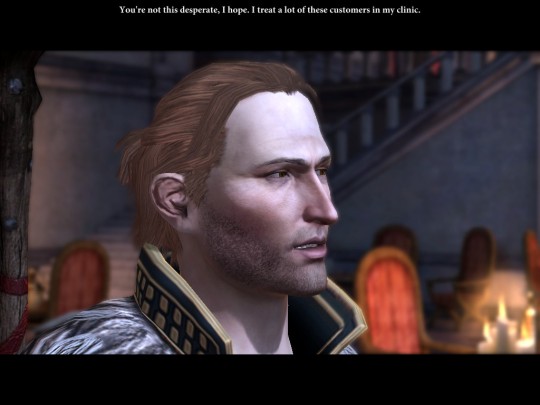
“You’re not this desperate, I hope. I treat a lot of these customers in my clinic.”
Then if you ignore the warning and do it anyways (you know, because Hawke)…
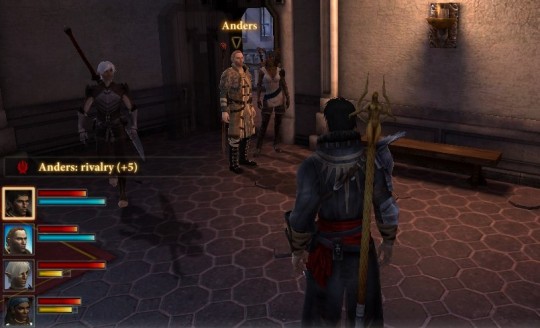
Anders: rivalry +5
It’s not a moral condemnation, a complaint about wasting time (à la Beth or Carver), or a vague expression of disgust (of the sort Fenris or Merrill reply with) — Anders, the closest in-universe equivalent to a doctor, is warning the player-character away from soliciting prostitutes on health grounds.
One interesting aspect of Dragon Age II is that it contains many more specific references to disease — which makes sense, given the medieval urban setting, where the top causes of mortality would realistically be infectious disease. Gamlen explicitly refers to his parents dying of “cholera,” a highly lethal (even today, untreated cholera has a case fatality rate of up to 50%) water-borne illness, and the water supply in Lowtown is described as dangerously contaminated (Hawke can refuse to drink it “even on a dare,” Merrill refers to something “twitching” in the water even after boiling it). A random NPC asking Lirene about “The Healer” complains, “I can't get my brother off the boat. The grippe's [i.e., the flu] got him bad.” Then there are the multiple references to unspecified STIs, all of which come from (or at least are associated with) Anders.
There’s an amusing line from Anders upon entering the Blooming Rose for the first time (usually but not necessarily during Enemies Among Us in Act 1):

“If someone tries to hire me again, I’m leaving.”
Now, some fans seem to read this as a claim that the Blooming Rose has tried to hire him as a sex worker, but I believe there’s a more plausible interpretation here. (Frankly, I have difficulty imagining that a brothel would be obsessed to the point of harassment with recruiting as their newest rent boy a man in his mid-30’s — and one who, need I remind you, lives in a mine shaft connected to a sewer and notorious for its toxic fumes, dumping of rotting corpses, and disease outbreaks. And no offense to any Andersmancer reading this, but is he really that good-looking?).
Most likely, the brothel is looking to hire an in-house physician (or Thedosian equivalent). Anders is referred to curing STIs and providing other reproductive care. In introducing him, Lirene says, “He's closed their wounds, delivered their children.” One of patients in her shop can be heard crying out, “My mother's in labor! The baby's come early. Can anyone help her?” To which Lirene replies, “I'll send word to the healer.” (Anders may have been delivering babies back in the Circle as well, considering that in MoTA, he says, “At the Circle, any accidental babies are taken away before the mother even sees them.” This could, however, simply be common knowledge among Circle mages). It’s also implied by Wynne that Circle mages practice contraception: “Such births [in the Circle] are seldom, as there are ways to prevent it, but it does happen.” Moreover, Anders appears to be the only person in Kirkwall willing and able to provide these medical services. There are references to useless quacks (e.g., “some purveyor of hensbane and leeches”), but it’s acknowledged in-universe that the only effective healing comes from mages. In DAI, the Inquisitor can express surprise at the presence of a “mundane” (non-mage) surgeon, who goes on to insist that such non-magical methods will be developed in the future, all of which further reinforces the (in-universe) social/cultural equation of healer as mage. Mage healers only appear to be let out of the Circle on rare occasions to treat members of the nobility, but ordinary people don’t receive such consideration. Even the viscount’s seneschal has to seek out Anders for help. In DAI, Cullen casually moons the idea of “healers’ clinics with templar support” (among other potential “opportunities to work outside the Circle”) as a totally novel solution to mage “resentment” over confinement. The Chantry thus far wasn’t willing to release mages to treat sick commoners even with phylacteries to deter escapes and Templar overseers breathing down their necks the entire time; in fact, they were rather reluctant to let out even a handful of senior mages to fight alongside the king against the Blight, something which threatened everyone’s lives fairly equally (and even then couldn’t resist the temptation to make the mages feel as unwelcome as possible). “The Healer of Darktown” was well-known to illicitly (that is, in defiance of Chantry restrictions) provide health care for free to the masses, and this service not surprisingly had earned him quite the number of admirers and defenders. Lirene resists being threatened for information about him by saying, “Any Fereldan in the city would lay down his life for the healer, after what he's done for us,” and a mob of Ferelden refugees even prepare to attack the heavily-armed party out of fear that the latter might harm him or report him to the Templars. His Act 2 Codex likewise reads: “When not with the Champion, he spends his time among the Fereldan refugees in Darktown, healing their ills and counting on their loyalty to protect him from curious templars.” Should it be a surprise then that a private business might be interested in his skills, especially when disease is threatening their bottom line and injuring customers?
In the game, we actually see two frequent patrons of the Blooming Rose end up in Anders���s clinic for treatment.
Dissent (Act 2), if Isabela has been left behind:
Anders: ...don't come running to me next time you pick up one of these diseases.
Isabela: Isn't that the point of magic?
Hawke: I don't want to know.
Dissent (Act 2), if Isabela is in the party:
Seneschal Bran: And that will, ah, stop the itch?
Anders: Yes. Though I would stay away from women you meet in the port. Pirates tend to... dock in unsavory places.
Isabela: I heard that!
Anders: Just use the salve if it comes back.
This is probably also what Isabela is referring to in the opening to Speak to Fenris (Act 2):
Isabela: So the seneschal's tax collector won't be coming around again, like you asked. Funny story.
Fenris: I'll pass, but thank you for the help.
Isabela: Spoilsport.
Seneschal Bran appears to be a regular with a particular fondness for Serendipity, a drag queen (or transfemme?) and one of the highest-paid workers at the Blooming Rose, whose gender nonconformity is generally Played for Laughs. Bran can be seen on a “date” with her at Duke Prosper’s party during Mark of the Assassin, and Serendipity can later be heard commenting, “I haven't seen the seneschal much lately. Don't tell me the man's gone religious” (to which someone responds, “No, he just keeps terrible hours now”).
Isabela, of course, talks about sex and her enjoyment of brothels (including the Blooming Rose) quite frequently. In Dragon Age Origins, we meet her dueling two men at The Pearl (Denerim’s main brothel), and she can (in)famously be talked into a threesome or foursome with the Warden and their LI, although in that game it was unclear whether she was hiring prostitutes or simply ended up there in the course of searching for dueling partners (given that the building had been occupied by mercenaries, and one of the optional quests in Denerim is to clear The Pearl of disruptive mercenaries on behalf of the city guard) or following/checking on her crewmen. In DA2, it is confirmed that she was going to The Pearl for sex, and Anders remarks, “You used to really like that girl with the griffon tattoos, right?” to which Isabela replies with the name “The Lay Warden.”
(For now, I’ll just ignore the unfortunate implications of Bioware depicting a promiscuous black woman repeatedly contracting STIs and unrepentantly spreading them to white men for blackmail purposes. But yeah, yikes).
Historically, the emergence of STIs as a major social problem has been associated with urbanization and military mobilizations — basically, situations in which large numbers of individuals had opportunities for unprotected sex, especially with multiple partners, away from the usual social control mechanisms such as cockblocking parents (and virtually all sex was unprotected until latex condoms began to be mass-produced in the 1920s-30s). Without the safety measures we have in place in licensed brothels today (e.g., condom requirements, regular STI testing), brothels and red light districts were superspreader bonanzas, and perhaps unsurprisingly, medical professionals tended to take a rather dim view of them, to put it mildly. Modern readers often historical interpret opposition to brothels and camp followers (in the military) on the part of medical and public health authorities as expressions of prudery, religious conservatism, and/or misogyny, and to be frank, they very often were. Yet at the same time, in the pre-condom and pre-antibiotic era, STIs represented a major public health burden and cause of disability, disfigurement, infertility, and premature death, and there few practical measures beyond simply urging everyone to keep their pants on (which worked about as well as one might expect).
Circling back to Anders, it's notable that he takes a much more negative view of sex in the second game than in Awakening, during which he seemed eager to hump anything that moved. This could at least in part reflect the influence of Justice, who seems to regard anything other than fighting for justice and engaging in public service to be "selfish" and even slothful (as in demon-y sloth). Or simple aging and maturity. Or, on a meta level, it could be an odd re-characterization due to the change in writer. But I like to think that his newfound discomfort with no-strings-attached boning is an unfortunate side effect of being a charity doctor working into the late hours to accommodate an endless stream of dick wart patients. It's already a shame that his clinic and service for the poor is relegated to such a background element, especially given the role such work would realistically play in forming a person's character. In terms of character development, it would have been interesting to explore how his work in the clinic could itself had a radicalizing effect — after all, it would bring him face-to-face with the tragic consequences of Chantry policy on mundanes (rather than just mages) as well as demonstrate magic’s contribution to the greater good on a daily basis. But this angle unfortunately never comes up in-universe.
TL;DR What I'm actually saying is that the real tragedy of Anders's character arc is the profound decrease in sluttiness between the two games.
#dragon age#dragon age 2#dragon age meta#anders#anders*#anders dragon age#da meta#dragon age ii#da2#dragon age awakening#justice#spirit of justice#the blooming rose#isabela#Isabela dragon age#isabela rivaini#seneschal bran#serendipity#fenris#madame lusine#sti#std#disease#history of disease#100#200#300#400
493 notes
·
View notes
Note
What kind of worldbuilding would you expect from a world where amputation is really common? (NOT a cyberpunk thing. The technology is somewhere between Bronze Age and Middle Ages, which I know is really broad but I’m indecisive). Also the most common cause of amputation is disease, not war or anything like that, in case it makes a difference. So far all I’ve come up with is that assistive technology isn’t limited to more urban/populated areas, and people treat amputations as commonplace. Sorry if this is too random
Ok, so my answer to this will depend of what kind of tone you want. Do you want it to be normalised in a more idealist/optimistic way, or do you want to do worldbuilding around the new problems that would likely arise and take a more pessimistic approach? Either way there's a lot you can do with a setting like that and I absolutely love world building stuff like this! I was actually working on another post kind of similar to what you're asking for, so I have a lot prepared lol. apologies for the long post in advance.

Here are some questions/suggestions I would consider:
What are the views around Amputation in this setting? Do any stereotypes or beliefs appear around it?
Just because a disability is common, doesn't always mean it's accepted, or accepted unconditionally, nor does it mean people won't make odd assumptions about it. Obviously, if you want something more optimistic, you'll want to go with "it's just a normal part of life, most folks don't really think about it much" but in that case, even accepted disabilities get weird assumptions, stereotypes or even religious beliefs surrounding them. The best example of this in the real world is people who wear glasses. Most folks wouldn't even consider it a disability because it's just so normalised, but it is - glasses are a type of accessibility device. But what comes to mind when you think of someone who wears glasses? Chances are, it's someone smart, maybe a nerd? Glasses have nothing to do with intelligence but we associate people who wear them with it anyway. From what I found, that association formed in the middle ages, as monks and priests wore them to read, and those were people who studied religious texts and passed that information to the public. the common folk saw these people as a source of information and wisdom, forming the idea that glasses were worn by intelligent or wise people. If amputation is common and/or accepted, this kind of thing will probably happen with it too. If amputations are more common in some lines of work than others (either because that job leads to more amputations, or because a lot of people go into that line of work after their amputation) people will start to associate qualities needed for that job with amputees. For example, If the most common reason for amputation is illness, and if that illness is contagious, you might actually end up with a similar belief, that amputation is a sign of intelligence because doctors/healers, who people view as intelligent, are more likely to catch the illness, resulting in more amputations among doctors.
On the flip side, a lot of cultures have disabilities at the heart of many of their beliefs. For example, they idea of the fey replacing children with other fey, is thought to have been people's way of explaining neurodivergence like autism, ADHD and personality disorders before we had words for those disabilities.

Likewise, some European Christians believed people born with disabilities (including limb differences) could be explained by their mothers participating in witchcraft or deals with the devil. These disabilities were pretty common at the time due to malnutrition and a general lack of understanding about how to be safe while pregnant, but they lacked the medical knowledge to be able to explain it, and so superstition took over. If your setting has a similar level of medical knowledge/understanding, something similar might occur. Not every example of this is negative btw. It's thought that early ancient Egyptians believed disabilities such as blindness, especially if it was from birth, were the result of the gods calling them to speak for them. Similar lack of understanding about where the disability came from but this time it has a much more positive outcome.
Also, consider that if it's so normalised, people are going to be much less likely to be afraid of becoming amputees. This can be a positive thing, but it could have run on effects, both in the sense that people are less likely to care to take precautions to avoid things that could result in amputation, and that people may underestimate the impact it will have. Even in the real world, as being an amputee has become less stigmatised (though we are still far from normalised), some people have started underestimating how it will impact you. My prosthetist says the hardest part of his job is watching the realisation that a prosthetic won't be a magic cure hit his patients in real-time. this isn't to say being an amputee is always a terrible and awful and all the other things people think about disability, but it is a BIG adjustment that a lot of folks are unprepared for. In a setting where it's even more common, this is even more likely. It's also more likely that non-amputees will underestimate this impact, and say things like "but I know someone with the same amputation and they're fine!" when someone tries to say they can't/struggle to do something because of their amputation - something that also already happens to me irl lol. People are going to take to being amputees differently, they'll have different limits and different capabilities, how well does your society as a whole understand this?
Finally, think about if there are certain types of amputations that are more accepted/normalised/understood than others. In the real world, leg amputees tend to be more accepted than arm amputees in my experience, and larger amputations/multi-limb amputations carry more stigma and have a lot more bizarre misinformation and stereotypes about them. Is this the same for your world?
What is the general populations view of other disabilities?
Just because one disability is more common or accepted, doesn't mean they all are. This is especially important to consider for comorbid disabilities (disabilities that are connected to, are caused by having, or are usually seen alongside being an amputee). For example, a lot of leg amputees choose wheelchairs over prosthetics, but the degree of acceptance for that in your world will depend on people's view of wheelchair users as a whole. In real life, it's an unfortunate reality that the use of a wheelchair is looked down on and there are a lot of negative stereotypes about wheelchair users which deters a lot of leg amputees from using a wheelchair, even when they really need one. When leg amputees specifically use wheelchairs, we are often said to be giving up or even lazy for not "pushing through" or "trying hard enough" - I have another post here talking about that. This has resulted in a lot of amputee-specific spaces being completely inaccessible wheelchair users. An example of this would be a camp I used to attend specifically for amputees being held in a non-wheelchair accessible location until recently, or amputee clinics (where you go to see doctors who specialise in treating/rehabilitating amputees) having equipment needed for taking measurements essential for getting quality prosthetics, being unusable to people who can't stand up.
If they do accept other related disabilities though, there's more stuff to think about (which I'll come back to in the next few points)
Of course, how your world views unrelated disabilities is important to consider too, because chances are there's someone out there with both. How does the general view of disability affect those people? Are people more or less likely to accept that having this other disability means they won't be able to things other amputees can? I'm autistic for example and find it nearly impossible to wear my prosthetic when I'm in burnout, both because it's a lot of energy I don't really have, but also because when I'm in burnout, I'm very sensitive to certain textures, and the feeling of wearing my prosthetics when I'm like that is unbearably uncomfortable.
What has the acceptance/normalisation of amputees done to influence beauty standards?
You see this a lot in cyberpunk but it's worth considering for other settings too. Amputation can be a very visible disability if you want it to be, but in the real world, there is a big emphasis on "looking normal" because beauty standards. This isn't just a modern thing either, there are many stories of real-life knights who lost arms during battle and had armour made for them that hid their missing limb. They were functionally useless (except for maybe backhanding people lol) but the desire to look "normal" outweighed the need for functionality to many.
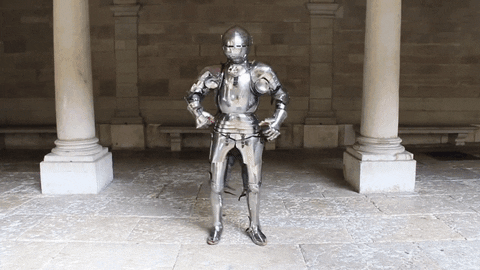
If amputation is common though, this might not be the case in your setting. This might mean people are freer to explore prosthetics that put function over aesthetics, meaning they might have more advanced prosthetics than you'd typically expect to see in that time period. Alternatively, it might go the other way and you could end up with people who still favour aesthetics over function, but they try to make it look as outlandish and unique as possible.
Beyond how it effects amputees though, if prosthetics are seen as fashionable, do non-amputees try to mimic the look of prosthetics in their outfits? Consider the first point I mentioned here too. If there are certain desirable characteristics associated with amputees, would people trying to present themselves a certain way try to make it look like they're an amputee, even when they are not? Kind of like how people wear fake glasses to look smart or just as an accessory.
Alternatively, how dose being an amputee play other beauty standards and expectations? Another real-world example, is that there is a lot of fatphobia in amputee circles, to the point where most teenaged amputees I know have/had eating disorders. Part of it comes from the general fatphobia in the wider population, but its amplified by the fact that many prosthetic components have weight limits on them, and many prosthetic companies refuse to make components for bigger people, not because they can't/it's too hard, but because they say there's no demand for it. So Doctors push the importance of staying below a certain weight so their patents can have access to better tech and it becomes a self-fulfilling prophecy. If there are a lot more amputees though, this might be different, but it's worth considering.
How will it impact architecture?

When we think of medieval or even older structures, "accessible" isn't the word we usually think of. Most buildings had stairs, and the needs of people with different bodies was rarely, if ever considered. But if amputation is more common, this might not be the case, especially if things like wheelchair use are also common/accepted (told you I'd come back to that). Buildings will be more likely to use ramps, lifts (even in ancient times - this could be achieved via pullies or something similar, though it would need to be usable to arm amputees too) or forgo multiple levels entirely where possible. Roads would probably be paved or at least smoothed to allow for easier travel via wheels and cities would be laid out in way that would make traversing them from a wheelchair easier. This would likely have a run-on effect and lead to cities being more accessible to people with horse-drawn carts, wagons, carriages etc too. things would be made with the idea that someone lower to the ground, or someone who needs to use their feet to grab things (and therefore can't reach as high) needs to be able to access the thing too, and a lot more. Even small things, like the way doors are opened might be altered to make it easier to use for someone missing an arm/who's arms are occupied with pushing a wheelchair. Making spaces more accessible in these ways also has run-on effects. I already mentioned the carriages in cities, but it also means you might start seeing small changes to the world, like chairs being made to be more comfortable, or single-handed versions of tools/weapons being more common.
What type of illness is the most common cause? How do people view it? Is it understood?
You mentioned illness is the most common cause of amputation in this setting. In that case, consider what kind of illness is usually the cause. Is it a single disease? if so, is it contagious? How high is the mortality rate? Who does it mostly impact? I lost my own legs to an illness, one that is well-known where I live, but poorly understood - most people just know it's contagious and acts kind of like the flu. This has resulted in some very bizarre interactions with non-disabled people when they find out how I lost my legs. There was a rumour about me in school that I still had the illness, and so because of that my amputations were contagious. It wasn't just children who believed it either lmao. Now as the public has been better educated, those ideas are less common, but weird stuff still comes up occasionally, like the lady who thought my illness was a government conspiracy theory made up to control people and scare them into getting vaccinated, apparently my amputations were unnecessary and all a part of the plot lol. I don't know if I talked about that on this account yet but I think it's probably my favourite weird interaction lmao.

You can also look at how people reacted to COVID for ideas about how people react to wide-spread illnesses that have a high chance of disabling you. Diabetes is another good example too, while it's one of the most common causes for amputation in the real world, people are still very weird about it and a lot of people insist it either doesn't exist or can be treated without medicine (insulin). Does the disease in your world have a lot of untrue information about it too? are there people peddling fake "cures" to take advantage of people who are more at risk?
How has this impacted Medicine as a whole
In medicine, advancements in one field are rarely isolated. When advancements are made in one area, other areas usually follow or are at least influenced. As much as the modern medical industry structure likes to pretend otherwise, it's all connected.
In the real world, amputees were a lot rarer (not unheard of mind you, but rarer) because well, bronze-age understandings of things like infection and disease in general wasn't great. people would often die from the side effects of the amputation or the surgery itself (e.g. infections, going into shock because the surgery was preformed while the person was awake, blood loss during surgery, a general lack of understanding of how important hygiene is post-op/a lack of access to proper hygiene etc). So if amputees are more common, that would imply their understanding of medicine is at least a little better than real-life bronze age folks.
This won't just stop an amputees though, like i said, it's all connected. Having a better understanding of, say, how infection happens in an amputee, means they will probably have a better understanding of infection in general, which could stop a lot of deaths in other ways. Likewise, sewing a stump closed in a way that won't cause immense amounts of nerve and phantom pain implies a decent understanding of the nervous system in general, which will have run on effects in how a lot of other conditions can be viewed and maybe even treated.
Conclusion
There's a lot more you could consider, but I hope this gave you some additional stuff to think about (sorry for the long response, but like I said, I was already working on a nearly identical post so this was perfect timing lol). Let me know if you need more help, I love this kind of worldbuilding stuff!
Also, just to be clear as well, as long as you aren't just ignoring the fact so much of your world is disabled or being super ableist about it, there's no right or wrong answers here. You can have more positive answers to these questions than what I've given as examples, you can go darker, you can have a mix of both, whatever you like. Depending on the tone you want, you don't even have to answer every question if you don't want to. If you have a rather light-hearted setting for example, you probably don't need to know how all your amputees are surviving infections and unmedicated amputation surgery lol, but if its a darker tone where the illness you mentioned is a central focus, then it's probably a good thing to think about at least. At the end of the day, just ensure your answers aren't based on stereotypes or misinformation and you're all good for the most part!
#id in alt text#long post#Writing Disability with Cy Cyborg#writing disability#disability representation#disabled#writing advice#writeblr#authors of tumblr#writing#authors#writer#on writing#writers on tumblr#writblr#writerblr#creative writing#amputee#amputee representation#worldbuilding#accessible worldbuilding#disability in worldbuilding#accessible settings
85 notes
·
View notes
Note
hello!! I just finished reading The Bolthole for the first time and ohhhh my god it’s so good. I loved the setting, I loved the way grief and guilt and coping and desire and deserving were explored for each of them, I loved how the way they felt about each other was so embodied and tactile and desperate.
I love the different sides of them we get to see and how their relationship intensifies when they’re out in the middle of nowhere together (feels like the parallel inverse of the beloved classic: trapped in a house in the city together). Would you choose middle of the city or out away from everything, for Draco and Harry? Do you have favorite bucolic stories?
Ohh The Bolthole is amazing and I agree, those vibes are immaculate! I love the elements you highlighted and I’m so happy that you enjoyed this fic; I remember the thrill of seeing those 3 brilliant authors publishing a story together, it felt like Christmas! I’m a very urban girl myself (love the city lights!) but I can’t deny the charm and quiet intimacy of bucolic fics, I especially adore the ones with recluse!Harry living in the woods. I loved doing this rec list, thank you!
Home is Where the Nifflers Are by primaveracerezos (G, 4k)
Draco has a soft spot for animals with nowhere to go; soon his and Harry's small flat is bustling with adorable, semi-dangerous creatures.
Vintage by momatu (T, 7k)
Of all of the vineyards, in all of the regions, in all of France, Draco's blasted editor sends him to Potter's....
Beekeeping by khalulu (E, 13k)
A few years after the war, Harry needs distance from the British wizarding world and volunteers abroad as a teacher in a poor rural school. Draco is a low-budget traveler, wandering wherever his curiosity leads him. Their paths cross in Malawi, “the warm heart of Africa.”
the treehouse near primrose downs by @softlystarstruck (M, 14k)
Draco and Harry have been roommates for years, so buying a magical house in the countryside shouldn’t be a big difference. But in between fresh loaves of bread and beds of wildflowers, things start to fall into place.
amid this warm and steady sweetness by warmfoothills (E, 21k)
Harry is not living in a period drama, no matter what his friends or his new house or Malfoy’s sudden affinity for horse-riding might suggest, and if one more person uses the word courting, he’s going to start hexing people.
Twelve Moons by @corvuscrowned (T, 27k)
Harry Potter lives a quiet life, running an inn with his two best friends. Once a month, Draco Malfoy comes to stay. A real-time fic that takes place over the course of a year; updates every full moon.
Pathless Woods by @shealwaysreads (E, 30k)
Harry finds himself unexpectedly reacquainted with Draco Malfoy when his work as an apprentice wandmaker takes him to Wiltshire. Amongst the trees Harry finds magic, growth, and a man who might finally be proving he’s worthy of the wand that chose him.
Of Wands and Trees by Omi_Ohmy (E, 45k)
All Draco wants to do is be a wandmaker, but to do so he needs to understand the soul of trees. Of course, the only man who might be able to help him is the one man who is more of a mystery to him than any tree.
Among Ancient Pines by @graymatters (M, 74k)
Every day, Draco Malfoy tries. With every fiber of his being he tries. But he doesn’t much think about what he’s trying for. In his final term of Healer training, Draco is unfortunate enough to find himself on a plane, the only means of traveling to a small, magical town in rural Alaska.
Knead by laughingd0g (E, 83k)
This is not a story about Harry renovating Grimmauld Place. This is a story about coffee shops and brewpubs, about Ginny and Luna on a farm with creatures, about magical Oregon, coastal road trips, flying, friendship, and Draco Malfoy's lean arms.
Wild (orphaned, E, 92k)
“No,” Harry said, by way of greeting. Malfoy’s blonde head rose slowly, carelessly. “Get out.” “I feel as though we’ve already established this, Potter,” Malfoy responded. “And I feel that what we established was that you telling me to get out of places really doesn’t make me more likely to vacate them.”
A Sword Laid Aside by @korlaena (E, 128k)
When Draco’s cover is blown during a deep undercover operation and the Ministry is compromised, Ron takes Draco to the only safe place he can think of—Potter. Hiding out with a taciturn Harry Potter, who has been missing from the Wizarding World for almost two decades after a shocking fall from grace, is nothing like Draco thought it would be.
78 notes
·
View notes
